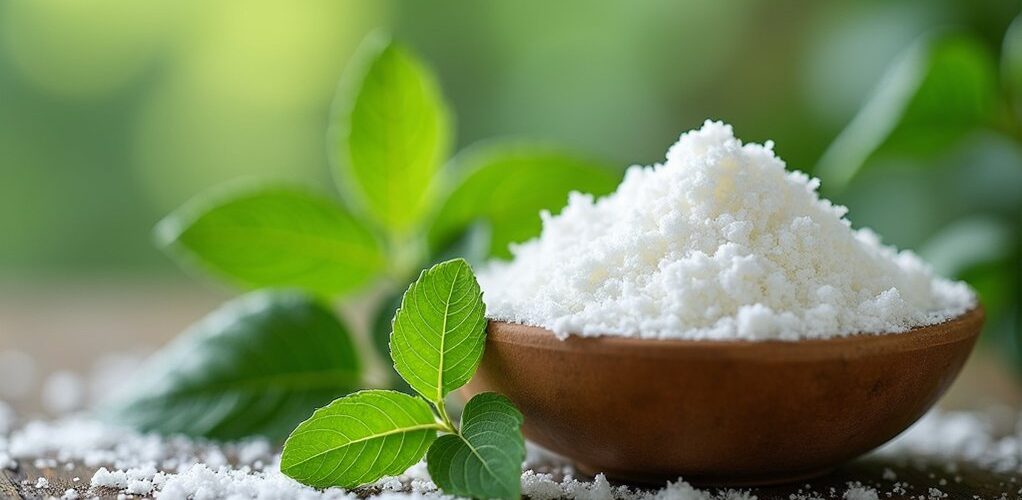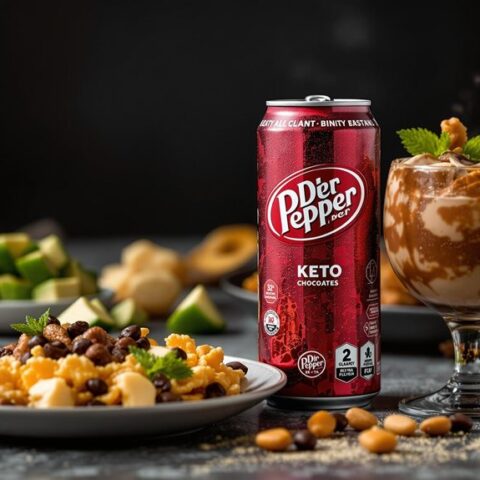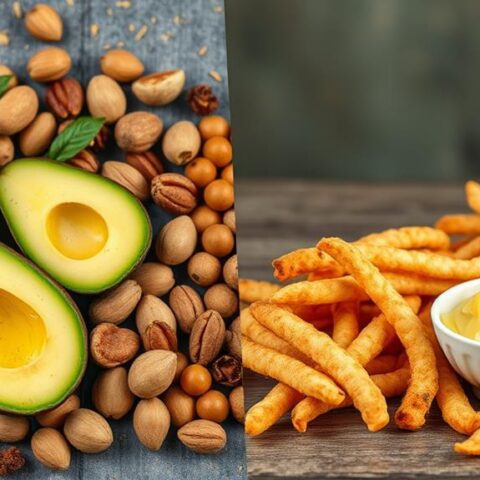
Stevia is a natural, zero-carb sweetener derived from the Stevia rebaudiana plant, making it ideal for low-carb and ketogenic diets. Its sweetness ranges from 200 to 400 times that of sugar, yet it doesn't impact blood glucose levels or contribute to dental cavities. Pure stevia contains no digestible carbohydrates, though processed versions may include carb-containing additives. Understanding stevia's properties and proper usage guidelines helps maximize its benefits while managing its distinct flavor profile.
Key Takeaways
- Stevia is a zero-carb natural sweetener derived from the Stevia rebaudiana plant, making it ideal for low-carb and ketogenic diets.
- The steviol glycosides in stevia pass through the digestive system without being metabolized into glucose or affecting blood sugar.
- Pure stevia contains no carbohydrates, but processed versions may include carb-containing additives, so label reading is essential.
- With sweetness 200-400 times greater than sugar, stevia provides intense sweetness without adding carbohydrates to your diet.
- Scientific research confirms stevia's zero glycemic index and its safety for maintaining stable blood sugar levels.
What Makes Stevia Different From Other Sweeteners
While many artificial sweeteners have flooded the market in recent decades, stevia stands apart due to its natural origins and unique properties. As a natural sweetener derived from the Stevia rebaudiana plant, it delivers exceptional sweetness at 200 to 400 times the potency of regular sugar, while containing zero calories and carbohydrates. This remarkable combination makes stevia an ideal choice for those following low carb dietary patterns.
Unlike conventional sweeteners, stevia doesn't trigger blood glucose fluctuations, setting it apart from both sugar and certain sugar alcohols. Its versatility in various forms, including liquid, powder, and granulated options, allows for easy incorporation into different foods and beverages.
Additionally, the steviol glycosides responsible for its sweetness don't contribute to dental cavities, making it a healthier alternative to sugar.
The Science Behind Stevia's Zero Carb Content
Understanding stevia's zero-carb content requires examining its molecular structure and the way the human body processes it. The steviol glycosides found in this non-nutritive sweetener are responsible for its intense sweetness, being 200-400 times sweeter than regular sugar, while containing no digestible carbohydrates.
When consumed, these compounds pass through the digestive system without being metabolized into glucose, making stevia a perfect choice for low carb and ketogenic diet followers. Scientific research and FDA recognition have confirmed that stevia's unique molecular composition allows it to provide sweetness without impacting blood glucose levels or contributing to daily carbohydrate intake.
This makes it particularly valuable for individuals who need to monitor their carb consumption while still enjoying sweet flavors in their diet. Stevia is a natural sweetener with a glycemic index of 0, making it an ideal low-carb alternative.
Natural vs. Processed Stevia Products
Natural stevia and its processed counterparts represent two distinct categories in the stevia sweetener market, each offering different benefits and considerations for consumers following low-carb diets.
While pure, natural sweeteners from the stevia plant contain zero carbs and provide intense sweetness without calories, processed stevia products may include additional ingredients that affect their carb content.
The manufacturing process used to create processed stevia products can influence both sweetness intensity and taste profile, with some versions incorporating fillers or other sweeteners.
For those strictly adhering to low-carb diets, it's essential to read labels carefully, as processed versions might contain maltodextrin or other carbohydrate-containing additives.
Understanding these differences helps consumers make informed choices between natural and processed options while maintaining their dietary goals.
Incorporating natural sweeteners like erythritol or stevia instead of artificial ones can support ketosis and maintain a low-carb intake effectively.
Blood Sugar Impact and Glycemic Index
Many individuals monitoring their blood sugar levels find stevia to be an exceptional alternative to traditional sweeteners due to its zero glycemic index rating. This natural sweetener does not raise blood glucose levels upon consumption, making it particularly beneficial for those following a low-carb lifestyle or managing diabetes. Research has revealed that stevia offers additional benefits beyond its zero-carb profile. Studies indicate that this sweetener may enhance insulin production, potentially improving blood sugar regulation in people with insulin resistance. Clinical research has demonstrated stevia's antihyperglycemic properties, which can help reduce blood glucose levels in diabetic patients. For those adhering to ketogenic or low-carb diets, stevia's lack of carbohydrates and calories makes it an ideal solution for maintaining sweetness in foods without compromising dietary goals. A ketogenic diet greatly reduces blood glucose levels and stabilizes HbA1c, preventing harmful blood sugar spikes.
Stevia's Role in Ketogenic Diets
When following a ketogenic diet, stevia emerges as an essential tool for maintaining strict carbohydrate limits while satisfying sweet cravings. As a natural sweetener containing zero calories and carbs, stevia seamlessly integrates into the low carb lifestyle without disrupting ketosis or compromising dietary goals. The plant-based sweetener's ability to regulate blood sugar levels makes it particularly valuable for those on a keto diet, as it doesn't trigger insulin spikes that could interfere with fat-burning processes. Its intense sweetness, ranging from 200 to 400 times that of sugar, means only minimal amounts are needed in recipes and beverages. Additionally, research indicates that stevia may enhance insulin sensitivity, providing an extra benefit for individuals managing their carbohydrate intake through ketogenic eating patterns. Furthermore, incorporating keto-friendly dairy options like butter and hard cheeses can complement stevia-based desserts and beverages, supporting a well-rounded keto diet.
Common Forms and Recommended Dosages
Stevia products come in several distinct forms, each tailored to specific culinary applications and user preferences. The recommended substitution ratio for powdered stevia is approximately 1 teaspoon per cup of sugar, reflecting its intense sweetness level of 200-400 times that of regular sugar. When using stevia for baking, careful measurement is essential to avoid potential bitter aftertaste.
| Form | Usage | Recommended Dosage |
|---|---|---|
| Powdered | Baking, cooking | 1 tsp per cup sugar |
| Liquid | Beverages, sauces | Brand-specific guidelines |
| Granulated | General sweetening | Follow package instructions |
| Pre-measured packets | Single-serve portions | 1 packet per serving |
For best results with liquid extracts, users should consult specific brand guidelines, as concentrations can vary greatly between manufacturers.
Converting Sugar Recipes to Stevia
Converting sugar-based recipes to use stevia requires careful attention to proper measurement ratios, with one teaspoon of powdered stevia typically replacing one cup of sugar due to stevia's intense sweetening power.
When adapting recipes, bakers must account for the moisture and volume differences between sugar and stevia, often requiring additional liquid ingredients or bulking agents to maintain the desired texture and consistency.
Common pitfalls include over-sweetening, which can result in a bitter aftertaste, and failing to adjust other recipe components to compensate for stevia's unique properties in baking applications.
Baking With Stevia Tips
Transforming traditional sugar-based recipes to use stevia requires careful consideration of several key factors. When making the conversion, remember that stevia's intense sweetness means using approximately one teaspoon for each cup of sugar in recipes.
Since stevia doesn't provide the same structural properties as sugar, bakers should incorporate ingredients like applesauce or yogurt to maintain proper moisture and texture in their baked goods.
To achieve ideal results when baking with stevia, monitor cooking temperatures and times closely, as stevia can caramelize more rapidly than sugar.
Additionally, pay attention to product-specific conversion ratios, as different stevia brands may vary in sweetness levels. To avoid an unpleasant bitter aftertaste, use stevia sparingly and measure precisely, following manufacturer guidelines for the best outcome.
Stevia Conversion Chart Guide
When working with sugar-based recipes, accurate conversion measurements between sugar and stevia are essential for successful results.
As a sugar substitute for low-carb diets, stevia's intense sweetness requires precise measurements to achieve ideal sweetness levels without bitter aftertaste.
For reliable recipe conversion, follow these guidelines:
- Replace 1 cup of sugar with 1 teaspoon of powdered stevia (4 grams) to maintain equivalent sweetness.
- When using liquid stevia, consult brand-specific instructions, as 1 teaspoon typically equals 1 cup of sugar.
- Combine 1 cup of erythritol with 1 teaspoon of stevia for improved texture in baked goods.
These conversions serve as starting points, and slight adjustments may be needed based on personal taste preferences and specific recipe requirements.
Common Substitution Pitfalls
Recipe substitution with stevia presents several common challenges that can affect the final outcome of baked goods and other dishes. When converting sugar recipes to use this natural sweetener, bakers often struggle with maintaining proper texture due to stevia's lack of bulk compared to traditional sugar.
Additionally, achieving the right sweetness level can be tricky, as stevia is notably more potent than sugar, requiring careful attention to conversion ratios.
Another notable pitfall occurs in recipes that depend on sugar's caramelization properties. Since stevia doesn't brown or caramelize like sugar, certain desserts and baked goods may not develop the desired color or texture.
Excessive use of stevia can also result in an unwanted bitter aftertaste, making it essential to follow proper conversion guidelines and adjust quantities based on specific brand recommendations.
Potential Health Benefits Beyond Sugar Replacement
Beyond its role as a zero-calorie sweetener, stevia offers several remarkable health benefits that make it an attractive choice for health-conscious individuals. Research demonstrates its effectiveness in supporting metabolic health through improved insulin sensitivity and blood sugar management, particularly beneficial for those with diabetes or insulin resistance.
- Stevia actively promotes better blood sugar control by stimulating insulin production while maintaining its low carb profile.
- Unlike artificial sweeteners, stevia passes through the digestive system without disrupting beneficial gut bacteria.
- The natural compound contains powerful antioxidant properties that protect cells from damage and may inhibit certain cancer cell growth.
Additionally, stevia can be a valuable tool for individuals following a keto diet for diabetics, as it aids in maintaining stable blood sugar levels without adding carbohydrates to the diet.
These benefits extend well beyond simple sugar replacement, making stevia a valuable addition to a health-conscious lifestyle while supporting overall wellness and metabolic function.
Digestive Effects and Tolerance Levels
While stevia is generally safe for gut health and compatible with digestive processes, some individuals may experience temporary discomfort such as bloating or nausea when first incorporating it into their diet.
Understanding personal tolerance levels through gradual introduction can help users identify their ideal consumption amount, with most people finding success starting with small quantities and adjusting as needed.
Research indicates that stevia has minimal impact on beneficial gut bacteria compared to other sweeteners, making it a reliable choice for those seeking a low-carb alternative without significant digestive concerns.
Gut Health Basics
When considering stevia's effects on digestive health, users can take comfort in knowing that this natural sweetener typically proves gentle on the gut. As a non-nutritive sweetener, stevia passes through the digestive system without metabolization, making it an excellent low carb option for those monitoring their intake.
Research highlights several key benefits of stevia for gut health:
- Minimal impact on gut microbiota compared to artificial sweeteners
- Natural antioxidant properties that protect digestive cells
- Low risk of digestive issues when consumed in moderation
While most individuals tolerate stevia well, some may experience mild gastrointestinal symptoms with excessive consumption.
Understanding personal tolerance levels and practicing moderation in consumption helps guarantee ideal digestive comfort while enjoying this natural sweetener's benefits.
Side Effects Overview
Although stevia has gained popularity as a natural sweetener, users should be aware of potential side effects that may occur with its consumption.
While stevia generally doesn't affect blood sugar levels, some individuals may experience digestive issues such as bloating, gas, or diarrhea, particularly when consumed in large quantities.
Health authorities have established an acceptable daily intake of 4 mg per stevia per kilogram of body weight, providing a safe guideline for consumption.
Individual tolerance varies considerably, making it essential to introduce stevia gradually into one's diet. Those new to stevia should start with small amounts and monitor their body's response before increasing intake.
Following these guidelines and practicing moderation helps minimize the risk of gastrointestinal discomfort while enjoying the benefits of this natural sweetener.
Consumption Guidelines
Proper consumption guidelines help users maximize the benefits of stevia while minimizing potential digestive discomfort. The recommended daily intake of 4 mg per kg of body weight provides a safe framework for consumption, while being mindful of individual tolerance levels.
Since stevia contains zero carbohydrates, it's an excellent sweetener choice for those monitoring their carb intake.
To guarantee ideal tolerance when incorporating stevia:
- Start with small amounts to assess individual sensitivity and potential digestive effects
- Gradually increase intake while monitoring for any signs of gastrointestinal discomfort
- Pay attention to serving sizes, as excessive consumption may lead to bitter aftertaste or bloating
These guidelines help users adapt to stevia consumption while maintaining comfort and achieving their dietary goals.
Combining Stevia With Other Keto Sweeteners
By combining stevia with other keto-friendly sweeteners, individuals can create an ideal balance of sweetness while maintaining their low-carb lifestyle. The synergy between stevia and erythritol proves particularly effective, as erythritol's cooling properties complement stevia's distinct taste profile, making it excellent for baking and beverages. Stevia also pairs well with monk fruit sweetener, offering a broader spectrum of sweetness without adding carbs or calories. This combination helps minimize any potential aftertaste while maintaining zero-carb status. When experimenting with xylitol and stevia blends, users should monitor their tolerance, as xylitol may cause digestive discomfort in larger quantities. Lily's Sweets offers stevia-sweetened chocolate bars as a popular choice for health-conscious consumers, ensuring a delicious treat that aligns with keto-friendly goals. Finding the perfect ratio of stevia to other keto sweeteners often requires personal experimentation, as individual taste preferences and product concentrations can vary considerably.
Reading Labels: Hidden Carbs in Stevia Products
When selecting stevia products, consumers need to carefully examine nutrition labels to identify hidden sources of carbohydrates that manufacturers often incorporate.
While pure stevia extract contains zero carbs, many commercial stevia products include added ingredients that can impact carbohydrates per serving, potentially affecting ketogenic diet goals.
Pure stevia may be carb-free, but watch for added ingredients in commercial products that can derail your keto journey.
Critical factors to examine on stevia product labels include:
- Bulking agents like maltodextrin or dextrose, which contribute hidden carbs
- Blend components such as erythritol or xylitol that may contain their own carbohydrate content
- Serving size variations between brands, which can affect total carb calculations
Understanding these elements helps consumers make informed choices about stevia products, especially when following a low-carb lifestyle.
FDA-approved stevia extracts offer the most reliable option for those strictly monitoring their carbohydrate intake.
Best Practices for Cooking and Baking
Moving beyond label reading, successful cooking and baking with stevia requires understanding its unique properties and making appropriate adjustments to traditional recipes. Following best practices is essential, as stevia's intense sweetness means using approximately 1 teaspoon of powdered stevia for every cup of sugar in recipes. For ideal results, combine stevia with bulk-adding ingredients like erythritol when baking.
| Recipe Type | Best Practice | Form to Use | Key Consideration |
|---|---|---|---|
| Beverages | Start with less | Liquid | Easy mixing |
| Baked Goods | Mix with bulk agents | Powdered | Texture control |
| Dressings | Adjust gradually | Liquid | Balance flavors |
| Desserts | Test sweetness | Either form | Avoid bitterness |
When cooking with stevia, remember it won't caramelize like sugar, making it unsuitable for recipes requiring this chemical reaction.
Managing the Aftertaste and Flavor Profile
Successfully managing stevia's distinctive aftertaste represents a key challenge for many users incorporating this natural sweetener into their diets.
While stevia offers a natural sugar alternative, mastering its unique aftertaste is crucial for creating truly enjoyable low-carb dishes.
Understanding stevia's intense sweetness, which can be up to 400 times stronger than sugar, is essential for achieving ideal flavor profile in low-carb recipes. Experimenting with different forms and combinations can help minimize any unwanted taste characteristics.
To effectively manage stevia's aftertaste, consider these proven strategies:
- Combine stevia with other low-carb sweeteners like erythritol or monk fruit to create a more balanced sweetness.
- Incorporate complementary flavors such as vanilla or chocolate to mask potential bitter notes.
- Start with small amounts and adjust gradually, as stevia's concentrated sweetness can easily overwhelm dishes.
For those following a keto diet, almond flour is a popular ingredient that pairs well with stevia to create delicious low-carb baked goods.
Long-term Effects on Weight Management
Although stevia's role in long-term weight management shows promise, research indicates its effectiveness depends on multiple factors beyond simple calorie reduction. Studies suggest that incorporating stevia into low-carb diets may support weight management goals through reduced caloric intake, as it contains zero calories and carbohydrates. However, its impact on appetite regulation varies among individuals, with some research revealing mixed effects on hunger signals and eating patterns. Current evidence points to potential benefits for metabolic health when using stevia as a sugar substitute, which could indirectly support weight management efforts. While stevia's zero-calorie profile makes it an attractive option for those monitoring their weight, success ultimately depends on overall dietary habits and individual responses to this natural sweetener. Additionally, incorporating stevia into a ketogenic diet could enhance fat burning and energy levels, as the diet's low carbohydrate intake aids in entering and maintaining ketosis.
Safety Studies and Research Findings
Extensive scientific research has established stevia's safety profile, with numerous studies confirming its suitability for human consumption across diverse populations.
Safety studies have consistently demonstrated stevia's gentle impact on digestive health and its potential health benefits, particularly for blood sugar management.
Key findings from research highlight stevia's positive attributes:
- Clinical trials confirm stevia's antihyperglycemic effects, showing improved insulin sensitivity in individuals with diabetes.
- Multiple studies verify that stevia passes through the digestive system without disrupting gut microbiota.
- Long-term studies indicate no adverse effects on blood sugar levels, blood pressure, or other essential health parameters.
Research continues to explore stevia's antioxidant properties and potential therapeutic applications, reinforcing its position as a safe, natural sweetening option supported by scientific evidence.
Frequently Asked Questions
What Is the Downside of Stevia?
Stevia's downsides include digestive issues, potential allergic reactions, bitter aftertaste affecting taste preferences, uncertain long-term effects, and possible health concerns when combined with other sweeteners, prompting some to seek natural alternatives.
Why Are People Avoiding Stevia?
People avoid stevia due to health concerns about digestive issues, taste preferences regarding its bitter aftertaste, and growing consumer awareness. Some prefer natural alternatives over artificial sweeteners due to dietary restrictions.
Why Is Stevia Being Discontinued?
Stevia products face production challenges and market demand shifts rather than widespread discontinuation. Regulatory changes, evolving consumer preferences, ingredient sourcing issues, and emerging health trends influence individual companies' product offerings.
What's the Truth About Stevia?
Stevia serves as a natural sweetener and sugar substitute, containing zero calories. It offers potential health benefits while being 200-400 times sweeter than sugar, making it versatile for various culinary uses.
Conclusion
Stevia stands out as a valuable option for those seeking to reduce carbohydrates while maintaining sweetness in their diet. Its zero-carb profile, natural origin, and minimal impact on blood sugar make it particularly suitable for ketogenic and low-carb lifestyles. While some may need to adjust to its distinct taste profile, stevia offers a scientifically-supported, safe alternative to sugar that can effectively support long-term weight management and health goals.









No Comments